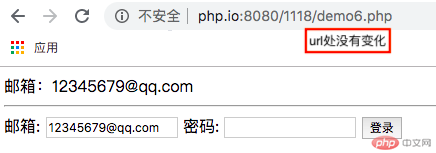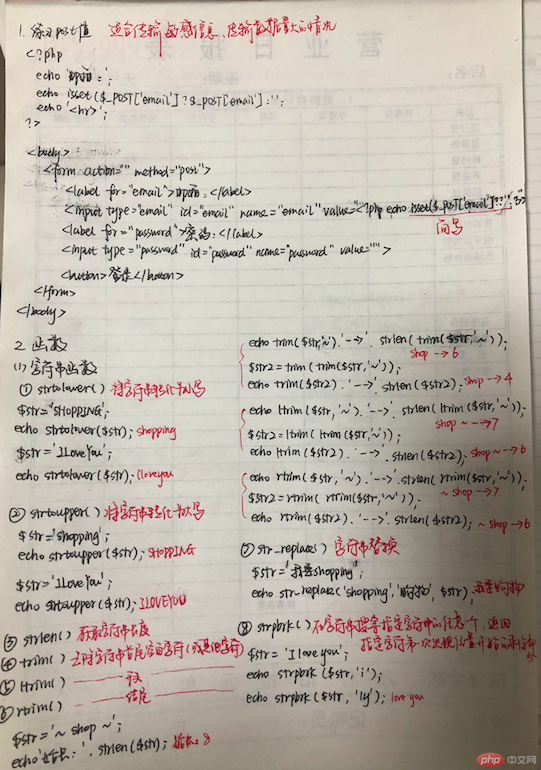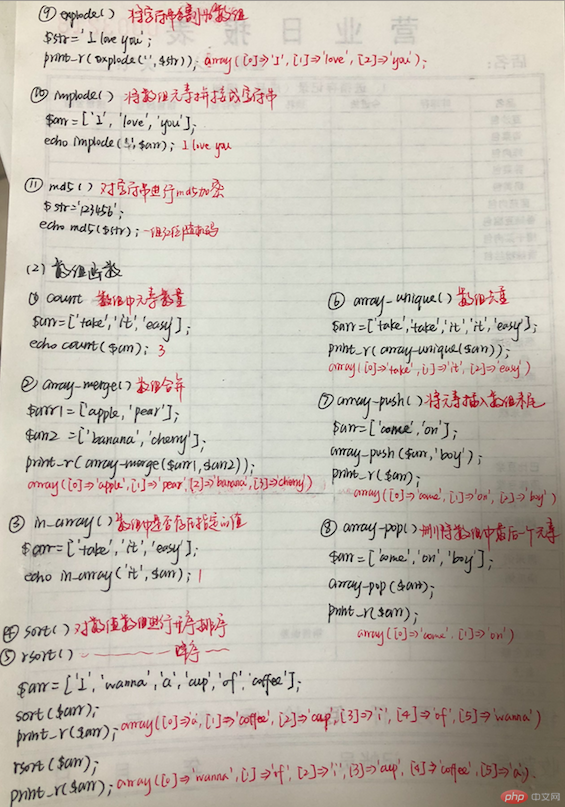1. 练习post传值(手写)
<?php# 2、POST 请求# POST请求, 参数不是通过URL传递, 而是通过请求头header, 适合敏感信息, 数据量大# 多用表单提交, php通过超全局变量$_POST获取, $_POST是一个数组, 键名就是POST参数名//print_r($_POST);echo '邮箱:' ;echo isset($_POST['email']) ? $_POST['email'] : '';echo '<hr>';?><!DOCTYPE html><html lang="en"><head> <meta charset="UTF-8"> <title>post</title></head><body> <form action="" method="post"> <label for="email">邮箱:</label> <input type="email" id="email" name="email" value="<?php echo isset($_POST['email']) ? $_POST['email'] : ''; ?>" required> <label for="password">密码:</label> <input type="password" id="password" name="password" value="" required> <button>登录</button> </form></body></html>


2. 函数自行学习一些
系统函数
<?php/* * 一、字符串函数 */# 1. strtolower() 将字符串转化为小写$str = 'SHOPPING';echo strtolower($str);echo '<br>';$str = 'ILoveYou';echo strtolower($str);echo '<hr>';# 2. strtoupper 将字符串转化为大写$str = 'shopping';echo strtoupper($str);echo '<br>';$str = 'ILoveYou';echo strtoupper($str);echo '<hr>';# 3. strlen() 获取字符串长度# 4. trim() 去除字符串首尾处的空白字符(或者其他字符)# 5. ltrim() 去除字符串开头的空白字符(或者其他字符)# 6. rtrim() 去除字符串结尾的空白字符(或者其他字符)$str = '~ shop ~';echo '始长: '. strlen( $str );echo '<br>';echo trim( $str,'~' ) . ' --> ' . strlen( trim( $str,'~' ) );echo '<br>';$str2 = trim( trim( $str,'~' ) );echo trim($str2). ' --> ' . strlen($str2);echo '<br>';echo ltrim( $str,'~' ) . ' --> ' . strlen( ltrim( $str,'~' ) );echo '<br>';$str2 = ltrim( ltrim( $str,'~' ) );echo ltrim($str2). ' --> ' . strlen($str2);echo '<br>';echo rtrim( $str,'~' ) . ' --> ' . strlen( rtrim( $str,'~' ) );echo '<br>';$str2 = rtrim( rtrim( $str,'~' ) );echo rtrim($str2). ' --> ' . strlen($str2);echo '<hr>';# 7. str_replace() 字符串替换$str = '我要shopping';echo str_replace('shopping','购物', $str );echo '<hr>';# 8. strpbrk() 在字符串中搜索指定字符中的任意一个# 返回指定字符第一次出现的位置开始的剩余部分。若未找到,返回false$str = 'I love you';echo strpbrk($str,'i'); //未找到echo '<br>';echo strpbrk($str,'ly'); //先找到了lecho '<hr>';# 9. explode() 将字符串分割为数组$str = 'I love you';print_r( explode(' ', $str) );echo '<hr>';# 10. implode() 把数组元素组合为字符串$arr = ['I','love','you'];echo implode(' ', $arr);echo '<hr>';# 11. md5() 将字符串进行md5加密$str = '123456';echo md5($str);echo '<hr>';/* * 二、数组函数 */# 1. count() 数组中元素的数量$arr = ['take','it','easy'];echo count($arr);echo '<hr>';# 2. array_merge() 数组合并$arr1 = ['apple', 'pear'];$arr2 = ['banana','cherry'];print_r( array_merge($arr1,$arr2) );echo '<hr>';# 3. in_array() 数组中是否存在指定的值$arr = [ 'take', 'it', 'easy' ];echo in_array('it',$arr);echo '<hr>';# 4. sort() 对数值数组进行升序排序# 5. rsort() 对数值数组进行降序排序$arr = [ 'i', 'wanna', 'a', 'cup', 'of', 'coffee'];sort($arr);print_r( $arr );echo '<br>';rsort($arr);print_r($arr);echo '<hr>';# 6. array_unique() 数组去重$arr = ['take', 'take', 'it', 'it', 'easy' ];print_r( array_unique($arr) );echo '<hr>';# 7. array_push() 将元素插入数组的末尾$arr = ['come','on'];array_push($arr,'boy');print_r($arr);echo '<hr>';# 8. array_pop() 删除数组中的最后一个元素$arr = ['come','on','boy'];array_pop($arr);print_r($arr);echo '<hr>';







